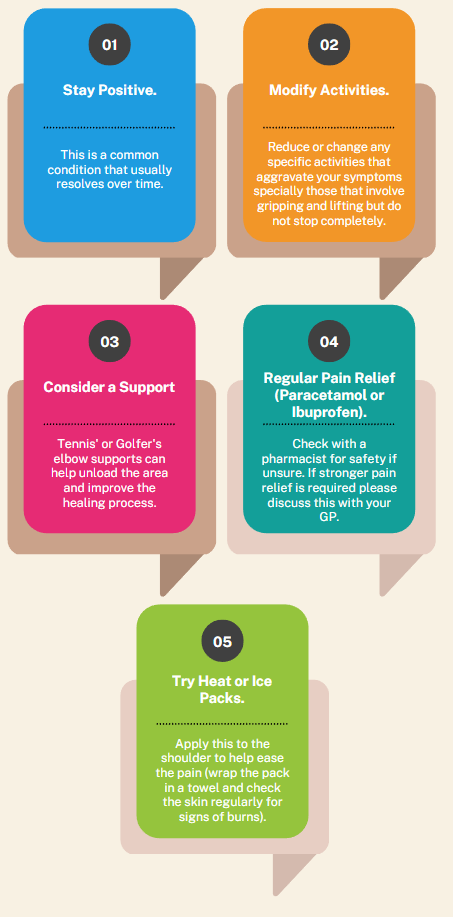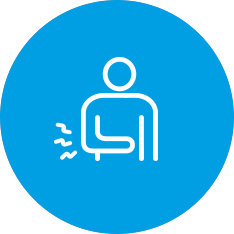Elbow pain
Elbow Pain
Elbow pain is common and some of us will experience elbow pain in our life. Most people who get elbow pain will greatly recover despite some recurrences. For a small group of people it may become persistent (lasting beyond 6-12 weeks) and can disrupt many aspects of a person’s life. Even if the pain is very bad, it is very rare for elbow pain to be a sign of something serious.
What are the symptoms?
Most people experience elbow pain in one or both of their elbows, but may also feel it down their forearm, and occasionally into the hand. Persistent elbow pain is typically elbow pain that has been going on for longer than 12 weeks.
Elbow pain may limit your willingness or ability to do certain activities, movements, or tasks. For some people this may affect their work, sleep, and social activities as well. These limitations often lead to people experiencing low mood, anxiety, and depression.
What are the causes?
Elbow pain can appear with no clear trigger, or some people can describe a movement that started the symptoms. This may be sports injury or a fall, but it can also be a simple movement we do a lot, usually with no issues, like picking something up, or sometimes just waking up with it.
The elbow has lots of muscles, tendons, ligaments, and nerves that might be involved in a pain episode. These structures can heal and repair if they have been injured or inflamed. It is not essential to identify the structures involved, as this will not usually change the advice you are given.
It can often be contributed by a combination of the factors below:
- Being inactive
- Doing too much
- Doing activities that we are not fit or strong enough for
- Being overweight or obese
- Poor fitness levels
- High stress levels
- Low mood
- Poor sleep
- Smoking
The good news is that many of these things can be modified as part of an effective treatment plan.
For more information to help support your general health and well-being, please click here to access our "Healthy You" page. This includes information on exercise, mental health, smoking and weight management.
How long will it last?
In many cases, with some simple advice, keeping active, and some lifestyle modifications, you may see a good improvement within 2-12 weeks. For some – pain can persist much longer because people adapt and cope in different ways. It important to know that for some people, life-long self-management is needed.
What can I do to help myself?

What else can I do?
Look to gradually increase what you can tolerate in terms of movement, activity, and exercises you can manage. Below you will find some resources/exercises to get you started with regards to your elbow pain. Start with the easiest and gradually work through them over time.
Elbow pain exercises - MODERATE
Elbow pain exercises - ADVANCED
You may prefer to increase your activity levels in other ways, such as simply walking, swimming, or joining an exercise class like Pilates, Thai chi, aquafit, or yoga.
The important thing is you find something you enjoy doing that you can do regularly to stay active.
Do I need an x-ray or a scan?
In most cases, no. A good history and physical examination of your elbow alone provides enough information to diagnose your problem. Scans and x-rays are not always useful for diagnosing elbow pain. While a scan or x-ray may provide information it rarely alters the treatment plan.
Imaging findings are very poorly linked with pain and often people with no pain have very similar findings on their scans/x-rays to those that do. X-rays and scans can help for a small number of people in certain situations and will be recommended by a healthcare professional if required.
Symptoms to check
Click the plus sign to see a list of problems that could be a sign you may need to be checked urgently
Get advice from 111 now if your arm/elbow:
- hurts when you exercise but the pain goes away when you rest
- you are experiencing chest pain/tightness with your elbow pain
- is swollen and you have a very high temperature or feel hot and shivery
- is extremely painful and difficult to move
- the pain is severe and started after an injury or accident, like a fall
- you have pins and needles or numbness that won’t go away
- has been injured and you heard a snapping noise or your arm has changed shape
111 will tell you what to do. They can tell you the right place to get help if you need to see someone.Go to 111.nhs.uk or call 111
Immediate medical advice is available by contacting NHS 111


 Elbow
Elbow